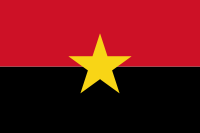
Flag of Angola
Encyclopedia
 |
 |
The national flag of Angola
Angola
Angola, officially the Republic of Angola , is a country in south-central Africa bordered by Namibia on the south, the Democratic Republic of the Congo on the north, and Zambia on the east; its west coast is on the Atlantic Ocean with Luanda as its capital city...
came into use at independence on November 11, 1975. It is split horizontally into an upper red half and a lower black half.
As in some other African countries, this flag is a modification of the ruling party's flag. The guerilla movement and later governing party, the Popular Movement for the Liberation of Angola
Popular Movement for the Liberation of Angola
The People's Movement for the Liberation of Angola - Labour Party is a political party that has ruled Angola since the country's independence from Portugal in 1975...
(MPLA), used the same design with a golden star in the center. Red stood for socialism and black for Africa. The star was modeled after the red star
Red star
A red star, five-pointed and filled, is an important ideological and religious symbol which has been used for various purposes, such as: state emblems, flags, monuments, ornaments, and logos.- Symbol of communism :...
of the Soviet Union
Soviet Union
The Soviet Union , officially the Union of Soviet Socialist Republics , was a constitutionally socialist state that existed in Eurasia between 1922 and 1991....
, which sponsored the MPLA.
Later the explanation was made less party-specific: The red is for the blood spilt by Angolans during their independence struggles
History of Angola
Angola is a country in southwestern Africa. Its name derives from the Kimbundu word for king, 'N'gola'. It was first settled by Bushmen hunter-gatherer societies before the northern domains came under the rule of Bantu states such as Kongo and Ndongo. From the 15th century Portuguese colonists...
, while the black is for the continent of Africa
Africa
Africa is the world's second largest and second most populous continent, after Asia. At about 30.2 million km² including adjacent islands, it covers 6% of the Earth's total surface area and 20.4% of the total land area...
. The symbol in the middle is of a crossed cog wheel
Gear
A gear is a rotating machine part having cut teeth, or cogs, which mesh with another toothed part in order to transmit torque. Two or more gears working in tandem are called a transmission and can produce a mechanical advantage through a gear ratio and thus may be considered a simple machine....
(representing workers and industry) and machete
Machete
The machete is a large cleaver-like cutting tool. The blade is typically long and usually under thick. In the English language, an equivalent term is matchet, though it is less commonly known...
(representing the peasantry) with a gold star. It was adopted during a time when Angola had a Marxist
Marxism
Marxism is an economic and sociopolitical worldview and method of socioeconomic inquiry that centers upon a materialist interpretation of history, a dialectical view of social change, and an analysis and critique of the development of capitalism. Marxism was pioneered in the early to mid 19th...
government, and thus was supposed to evoke the image of the hammer and sickle
Hammer and sickle
The hammer and sickle is a part of communist symbolism and its usage indicates an association with Communism, a Communist party, or a Communist state. It features a hammer and a sickle overlapping each other. The two tools are symbols of the industrial proletariat and the peasantry; placing them...
found on the flag of the former Soviet Union
Soviet Union
The Soviet Union , officially the Union of Soviet Socialist Republics , was a constitutionally socialist state that existed in Eurasia between 1922 and 1991....
, a common symbol of Communism
Communism
Communism is a social, political and economic ideology that aims at the establishment of a classless, moneyless, revolutionary and stateless socialist society structured upon common ownership of the means of production...
.
The flag is most recently described and explained in article 162 of the Constitutional Law of the Republic of Angola (Constitution) of August 25, 1992.
2003 proposal
In 2003, a new, more "optimistic" flag was proposed by the Parliament's Constitutional Commission of the National Assembly (Angolan Parliament), which so far has not been formally adopted. The sun design in the middle is meant to be reminiscent of cave paintingCave painting
Cave paintings are paintings on cave walls and ceilings, and the term is used especially for those dating to prehistoric times. The earliest European cave paintings date to the Aurignacian, some 32,000 years ago. The purpose of the paleolithic cave paintings is not known...
s found in Tchitundo-Hulu cave. The flag, while radically different in design and symbolism, maintains the same flag proportions of 2:3.
External links
- http://www.angola.org/referenc/proposed_flag.html

